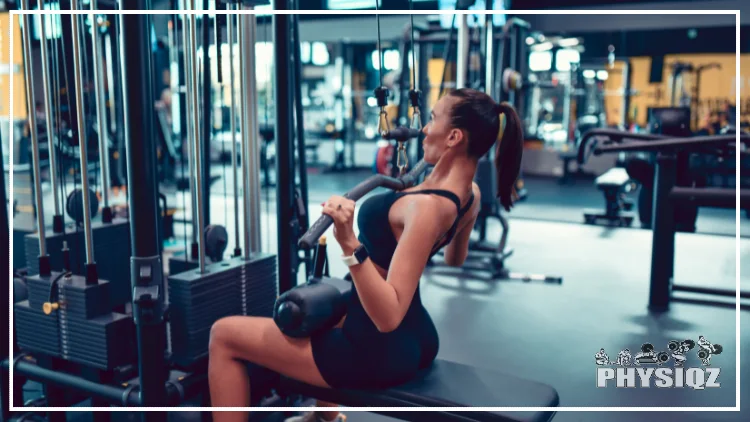
The dumbbell pullover is a great exercise and all, but those wanting to add more variety into their workout or have a shoulder injury should experiment with these 11 dumbbell pullover alternatives to hit multiple muscle groups and achieve a wider and thicker back.1
This article will not only go over the best alternate movements and why to use each, but will also review the different dumbbell pullover muscles worked and how to do them properly.
This will help every reader to get the most out of their workout and maximize their muscle growth.
What Makes an ExerciseOne of the A Good Dumbbell Pullover Alternatives
There are many aspects of an exercise that make a good alternative for dumbbell pushovers. Lifters should keep in mind the list below when choosing which substitution to try out, and are encouraged to mix up their workout routine with the alternative exercises to help achieve their lifting goals.
Keep in mind that narrow mindedness is one of the 8 deadly training sins, so don’t be afraid to try out a new exercise.
Muscle Groups
The primary focus when deciding if certain exercises are quality dumbbell pullover substitutes was if they worked the same or similar muscle groups. This allows for lifters to use the exercise on the same day as a replacement for the pullover exercise.
Keep in mind that some exercises on this list are back focused, while others are chest.
Compound Movement
Compound movements are exercises that cross at least two joints of the body, and as a result, work multiple muscle groups at the same time. They are a great way to maximize efficiency, and research suggests that compound movement exercises will help to maximize muscular size and strength when compared to non-compound movements.2
While not every dumbbell pullover alternative on this list fits this category, lifters focused on muscle growth might have better results with the ones that include compound movements.
Functional Exercise
Functional exercises are great because they focus on movement. This allows for lifters to see their exercise benefits in the real world, such as improving posture and flexibility, increasing range of motion, and preventing injury.
While not every alternative is a functional exercise, the ones that do incorporate stability, full range of motion, and multiple muscle groups will benefit the lifter.
Lat Focused Dumbbell Pullover Alternatives (Pullover Exercises)
Alternatives to dumbbell pullovers tend to fall into two different categories: back focused and chest focused. The exercises below focus on hitting the back muscle groups, with the latissimus dorsi or lats being primarily targeted.
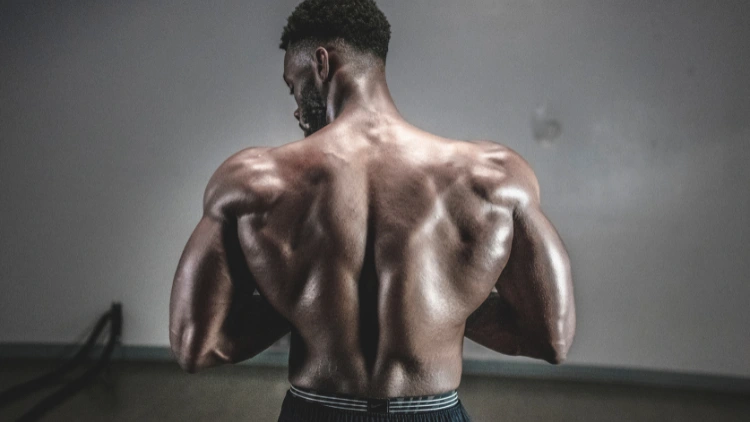
Source: Pikx via Canva.com3
Keep in mind that these exercises can also hit other muscles secondarily, and can be used to maximize a workout’s efficiency.
1. Standing Cable Pullover: Cable Rope Pullover or Lat Pullover With Cable Attachment
A cable pullover is great for targeting the back, and has the additional benefit of hitting other critical muscle groups that help to stabilize the scapula and shoulders. Furthermore the standing cable pullover will also engage the entire body through weight bearing, making the movement more functional.
This can be done with the rope or another cable attachment and it all depends what’s available and what you prefer.
How To: Make sure the weight is appropriately set and a proper attachment is used. Stand with feet shoulder length apart in front of the cable machine with hands in the palm down or pronated position.
Start with shoulders flexed and arms gripping the bar above the head, then press downwards for full range of motion. Slowly return to the start position.
Tips: When returning to the start position, make sure to slightly rotate the shoulders outward to prevent injury. This is referred to as scapulo-humeral rhythm, and will ensure the tendons and ligaments of the shoulder are not damaged.4
Those with bad shoulder genetics should pay close attention to correct form.
When To Use: This exercise should be used when wanting to target the muscle groups of the back. It can fit into any 4 day workout split.
Muscles Targeted: This exercise will focus on the latissimus dorsi, or lats for short. It has the additional benefit of hitting the rear delts or deltoids, the rhomboids of the back, and the lesser known teres major and biceps brachii muscles located on the lower scapula and upper arm respectively.
2. Lying Cable Pullover With Straight Bar (Straight Arm Cable Floor Pullover)
This is a killer exercise that is lats focused, but has the benefit of hitting multiple muscle groups at the same time. Because standing and balance is taken out of the equation, lifters can better focus on the muscles being worked during this exercise.
If you don’t have a cable machine, try lying dumbbell pullovers instead.
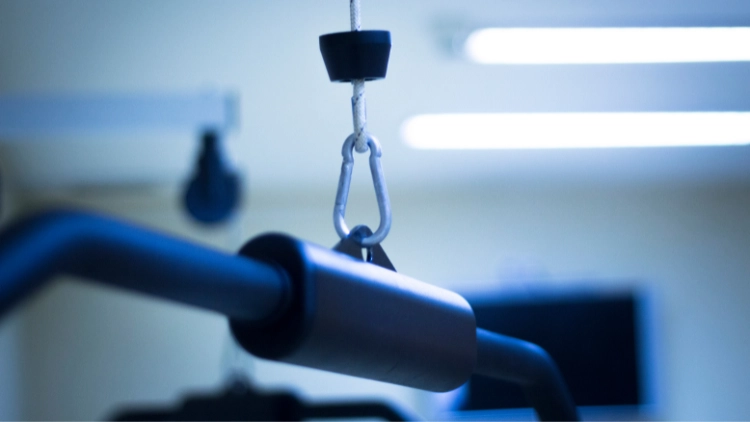
Source: Edward Olive via Canva.com5
How To: Lying on a flat bench or floor and facing away from the cable machine, a lifter will start with gripping the bar with their hands above their head and shoulders flexed to full range. They will then slowly extend the shoulders towards their hips.
Next, return back to the start position.
Tips: Because this exercise is in the lying position and cable based, it’s a good idea to save it for later in a workout when fatigue is at its max.
When To Use: Another good replacement for dumbbell pullovers, especially when wanting to focus on growing the back.
Muscles Targeted: This exercise will have a primary focus on the lats, while also hitting the delts, pecs, and tricep muscles.
3. Barbell Pullover or EZ Bar Pullover
This dumbbell pullover alternative is back day focused, but with a simple adjustment, it can easily hit the hard to reach tricep muscles too.
How To: Lay down on the bench with the bar pressed fully upwards. Next, keeping the elbows fully extended, slowly lift the bar above the head to end range of motion.
Next, return back to the start position.
Tips: If you want to hit the triceps too, instead of keeping the elbows extended, bend the elbows so the barbell is hitting the end range of motion just above the head. This variation is called a skull crusher.
When To Use: Use this compound exercise when wanting to hit the back, or try the skull crusher alternative when focusing on triceps. Skull crushes will keep proper tricep form, and are a great arm day addition.
Muscles Targeted: The lats is the primary muscle, but the pecs, posterior delt, triceps, and teres major will all be actively engaged.
4. Decline Pull Over With a Barbell, EZ Bar, or DB
This exercise will be very similar to the barbell or EZ bar pullover discussed above, but with one critical difference. Instead of a flat bench, a declined bench will be used instead.
Studies have found that a decline variation significantly increases muscle activation of the pec muscles.6
How To: Lay down on the decline bench with the preferred bar pressed fully upwards towards the ceiling. With the elbows fully extended, slowly lift the bar above the head to end range of motion.
Next, return back to the start position. The skull crusher variation can also be used to better hit triceps.
Tips: Use the decline bench when wanting to target the lower pec muscles in addition to lats. This is great for helping to define the chest, as well as adding variation to a workout.
When To Use: Use this compound exercise when wanting to hit the back. Try adding this alternative to any beginner hypertrophy program.
Muscles Targeted: This hits the same muscles discussed above, which are the lats, pecs, posterior delt, triceps, and teres major.
5. Pullover Machine (Hammer Strength or Nautilus Pullover Machine)
This is an ideal exercise for back day. The machine takes the worry out of stabilization, helping lifters to isolate the muscles being worked.
This is particularly beneficial for those struggling with balance, and prevents stabilization related injuries.
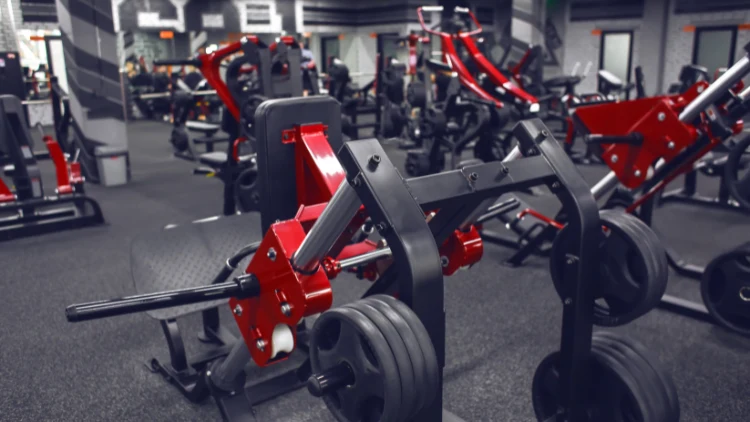
Source: pixelshot via Canva.com7
How To: Sit in the machine with the triceps area resting against the pads. This will place the arms in the air with shoulders in forward flexion.
Next, slowly press against the pads to lower the arms to full range of motion, then return to the start position.
Tips: Try using very slow and controlled movements, with pausing to squeeze at the end range of motion. This will help maximize muscular fatigue, and ultimately, muscle building.
When To Use: Use this exercise when wanting to focus on isolating the lats and pecs. This is ideal for a chest and back day, and can help a lifter really feel the work in both of these muscles.
Muscles Targeted: The primary muscle being worked for this machine is the lats, but the pecs are also targeted secondarily.
6. Pull Up
Pull ups are great because they fall into both the compound and functional movement groups. All that is really needed is the body and a bar that can be found at a local park playground, making it an accessible exercise as well.
Plus there are many variations that help to target different muscle groups, depending on the desired result.
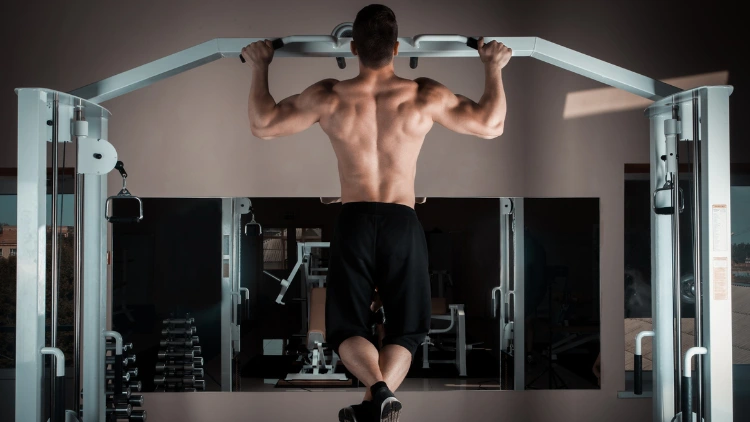
Source: takoburito via Canva.com8
How To: For a standard pull up, start by hanging from a bar with hands gripping in a palm down pronated position and spaced slightly greater than shoulder length apart. Next, pull upwards by moving the shoulder blade muscle towards one another, as well as engaging the back and arm muscles to move the body upwards.
Try to move until the chin area is completely above the bar before slowly lowering to the start position. Remember to keep the core and legs tight!
Tips: This exercise is best used at the start of a workout, because the lifter is working against gravity. Try adding more reps and sets, or even use a pull up belt to attach weight if you want to increase the intensity.
When To Use: This is a comprehensive back workout within itself, so it is best to use this exercise during back day. Research shows that a pronated grasp during this exercise creates significantly more muscle activation of the traps compared to other variations, and should be used when wanting to target this specific muscle.9
Muscles Targeted: The back muscles are the main target for this exercise, primarily the lats, traps, and rhomboids. The scapular muscles will also be working as a secondary, which include the teres muscles, infraspinatus, and levator scapulae, as well as the biceps and posterior delts.
7. Lat Pulldown
Lat pull downs are a great compound exercise that target multiple back muscles at once. It’s completed in the seated position with cables, making it a great way to focus specifically on the muscles being worked without worrying about the impact of poor stability.
How To: First, sit on the provided bench in front of the cable machine, with the lat bar attachment in use. Next, use a wide, pronated palm down grasp to grip the bar.
Hands should be resting on the part of the bar angled downward. In a slow and controlled motion, pull the lat bar downwards until it is resting above the chest, then return to the start position.
Tips: A lifter should make sure they are not leaning too far backwards, as this allows for compensatory movement and diminishes back muscle activation.
When To Use: Use on any back day workout to target the back muscles.
Muscles Targeted: The primarily mover are the lats, hence the exercise name. The traps will also be targeted, as well as the scapular muscles discussed above.
Even the biceps will be engaged as a secondary mover. Keep in mind that the close grip lat pulldown muscles worked might differ from the standard, wide grip.
8. Single Arm Sweeping Row & Sweeping Pull Up
Sweeping rows will add additional shoulder movement to increase range of motion, helping to improve the functionality of this exercise. Also because it’s a single arm variation, it allows the lifter to better focus.
The same sweeping motion can be done on pull ups as well although don’t expect to get the same range of motion.
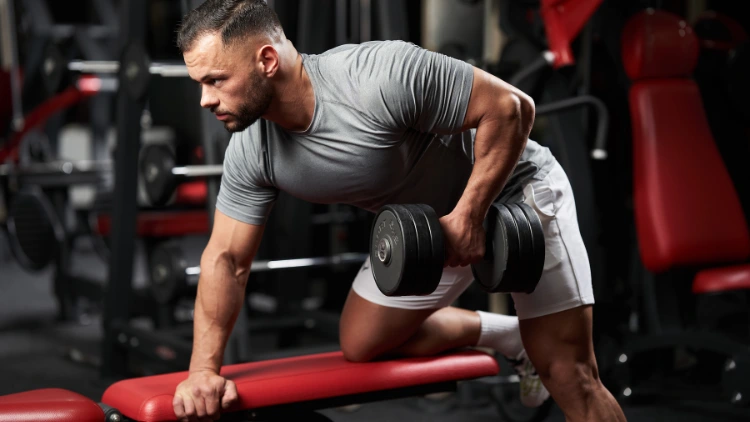
Source: Slatan via Canva.com10
How To: Start with the knee and palm of one side of the body resting on the bench, with the other arm holding the dumbbell in full elbow extension. Next, flex the shoulder forward about 60 degrees.
In a seamless movement, flex the elbow and bring the dumbbell to the hip while slightly turning the body. This maximizes the movement’s range of motion.
Tips: Because so much movement is used in this exercise, it’s easy to make mistakes that can damage the body. Pay very close attention to form, and how the movement feels.
When To Use: This is a great exercise for back day, as well as those who actively engage in rowing sports or kayaking.
Muscles Targeted: This is a lats focused exercise, but will additionally cause activation of the anterior and posterior delts, the scapula muscles, and biceps to a lesser extent.
Chest Focused Alternatives to DB Pullovers Workout
Chest focused dumbbell pullover alternatives are key for hitting both of the pec muscles, the pectoralis major and minor. These are a great addition to any push or chest day, and are ideal for those with bad chest genetics wanting to see muscle improvements.
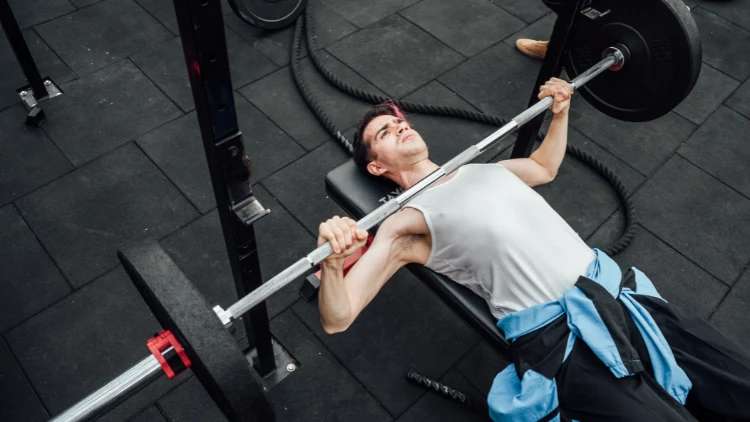
Source: Mike Gonzalez via Canva.com11
9. Dumbbell & Barbell Bench Press
The bench press is both a compound and functional exercise, helping to maximize muscle growth. In fact, studies have found that bench press results in greater primary muscle activation when compared to other chest based exercises.12
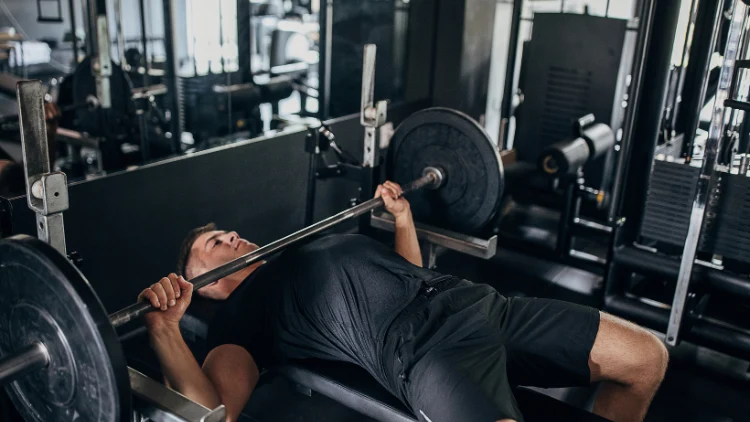
Source: Hirurg via Canva.com13
How To: Laying on a flat bench, start with arms fully extended and perpendicular to the body. Grasp the weight with a palm down, pronated position in relation to the body.
Slowly bend the elbows until the bar or dumbbells are hovering over the chest, and then push the weight upwards to the start position.
Tips: Try the decline bench position to better activate the pec major and minor muscles. Also consider the bench bar path, and the impact it has on muscle activation.
When To Use: This is a great chest day workout to include. Bench press can cause fatigue quickly, so make sure to use it at the start of a workout.
This exercise can fit easily into a 6 week powerlifting program.
Muscles Targeted: This focuses on the pecs major and minor muscle, with some tricep and anterior delt activation.
10. Dumbbell Flys
Dumbbell flys are an ideal free weight chest exercise. It makes for a great alternative to bench press, and requires less weight due to fully engaging the muscles.
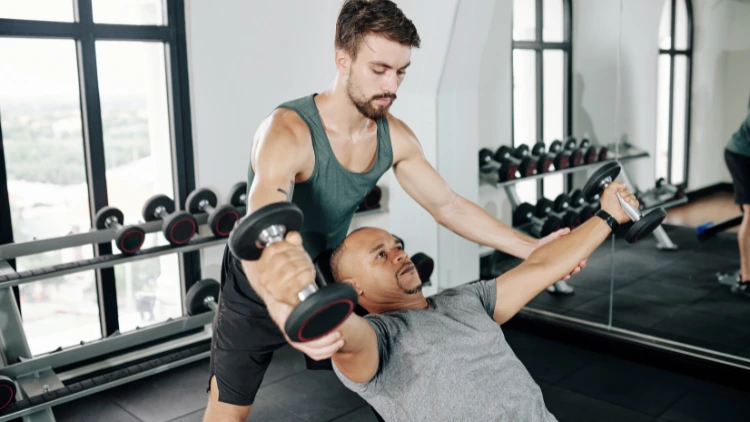
Source: DragonImages via Canva.com14
How To: Start laying on the back on the bench and dumbbells fully in the air, perpendicular to the body. Slowly move the arms away from each other, keeping the elbow fully flexed.
Go to the end range of motion before returning to the start position.
Tips: Less is more. Use less weight for this exercise, as more stress is being placed on the body due to the biomechanics of the movement.
When To Use: Try this exercise when wanting to target the chest and do not have access to high weight.
Muscles Targeted: This mainly hits the pec muscles, while also engaging the biceps and anterior delts to a lesser extent.
11. Iso Lateral Chest Press
This is an isolating exercise eliminating any worry in regards to balance and stabilization. Furthermore, the isolation of the muscle can aid in a lifter’s mind-body connection.
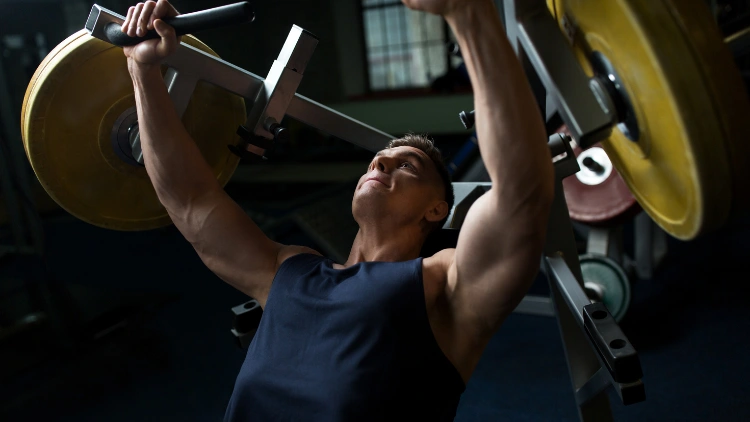
Source: SYDA Productions via Canva.com15
How To: Sit on the machine and adjust the incline and resistance. Next, grasp the handles with a palm down grip, and push the arms forward to full range of motion before returning to the start position.
Tips: Keep in mind the muscle groups wanting to be targeted. A more seated incline will increase shoulder activation, while less incline will better hit the chest muscles.
To better target shoulders, try out compound shoulder exercises to maximize delt size and strength.
When To Use: Depending on the incline chosen, this machine can be used for both chest and shoulder day.
Muscles Targeted: The chest press will activate both pecs, as well as the triceps and anterior deltoid as a secondary mover.
How To Choose the Dumbbell Pullover Alternatives That’s Right for You
Finding the best alternatives to dumbbell pullovers can be tricky, and will ultimately boil down to a lifter’s personal preferences and overall gym goals. To help determine which might be best to consistently incorporate, lifters should pay attention to how an exercise feels.
First, consider the mind muscle connection. This simply refers to the way the body is connected, through sensory and motor neurons that connect the brain to the muscle.
When it comes to a good workout, motor neurons are the main focus and can be used to maximize the connection to the mind, ultimately helping a lifter to really feel their muscle contractions and movements. Studies suggest that improving mind muscle connection during workouts can help increase muscle activation.16
Furthermore, pay attention to how the body is feeling. Ensure the muscles are properly fatigued at the end of the set.

Source: Klaus Nielsen via Canva.com17
And more importantly, listen for any signs of discomfort. Paying attention to what the body is saying is key to not only maximize a workout, but also prevent injury.
Standing exercises can be great for helping to target stabilization, while machines allow for isolation and injury prevention.
Finally, the best workouts typically have the greatest range of motion. To achieve this, opt for alternatives that use a bench rather than the floor to allow for more overhead movement.
Readers now know not only the best substitutes for a dumbbell pullover, but also which movements impact which muscles the most. Make sure to try any of the 11 dumbbell pullover alternatives listed above for guaranteed muscle building.
Frequently Asked Questions
Are the Alternatives of Dumbbell Pullover Better?
The answer will vary depending on the lifter, their preferences, and the muscles they are trying to work. Someone who is trying to target the back and triceps might better benefit from one of the alternatives of dumbbell pullover discussed above, while those wanting the traditional dumbbell pullover can find success with that exercise too.
Should I Do Dumbbell Pullover on a Bench or a Floor Pull Over?
Again, this comes down to personal preference. However, the bench may allow for more comfort from thicker padding, as well as offer alternatives by being able to adjust the incline and allowing for more range of motion.
Which Muscles Does the Dumbbell Pullover Work?
The dumbbell pullover targets the pecs primarily, while also engaging the lats, posterior delts, triceps, and teres major muscles around the shoulder blades.
Are the Alternatives of Dumbbell Pullover Bad for Your Shoulders?
When done improperly, dumbbell pullovers exercise can put additional strain and stress on the shoulder. To prevent this, make sure the scapulas are being rotated slightly outwards once the shoulders hit 60 degrees of forward flexion.
Is a Dumbbell Pullover a Push or Pull Exercise?
Because the dumbbell pullover primarily targets the chest, it is considered to be a push exercise. That being said, some pull muscles are also worked such as the back.
Is It Possible To Do a Dumbbell Pullover Without a Bench?
Yes, this exercise can be completed while laying on the floor or a more comfortable mat instead. However the floor version of this exercise will not have quite as large of a range of motion.
References
1AleksandarGeorgiev. Canva. Accessed 18 April 2023. <https://www.canva.com/photos/MAFZdLL2TfQ-lat-pulldowns-done-properly-by-female-athlete/>
2Paoli, A., Gentil, P., Moro, T., Marcolin, G., & Bianco, A. (2017). Resistance Training with Single vs. Multi-joint Exercises at Equal Total Load Volume: Effects on Body Composition, Cardiorespiratory Fitness, and Muscle Strength. Frontiers in physiology, 8, 1105. <https://doi.org/10.3389/fphys.2017.01105>
3Pikx. Canva. Accessed 18 April 2023. <https://www.canva.com/photos/MADyQ97A6RY-man-flexing-muscle/>
4Paine, R., & Voight, M. L. (2013). The role of the scapula. International journal of sports physical therapy, 8(5), 617–629. <https://www.ncbi.nlm.nih.gov/pmc/articles/PMC3811730/>
5Olive, Edward. Canva. Accessed 18 April 2023. <https://www.canva.com/photos/MACyk0fNTxA-weight-training-machine-in-fitness-gym/>
6Schütz, P., Zimmer, P., Zeidler, F., Plüss, M., Oberhofer, K., List, R., & Lorenzetti, S. R. (2022). Chest Exercises: Movement and Loading of Shoulder, Elbow and Wrist Joints. Sports (Basel, Switzerland), 10(2), 19. <https://doi.org/10.3390/sports10020019>
7pixelshot. Canva. Accessed 18 April 2023. <https://www.canva.com/photos/MAEHWw_DkPQ-modern-equipment-in-new-gym-indoors/>
8takoburito. Canva. Accessed 18 April 2023. <https://www.canva.com/photos/MADaqxaoOn8-pull-ups/>
9Dickie, J. A., Faulkner, J. A., Barnes, M. J., & Lark, S. D. (2017). Electromyographic analysis of muscle activation during pull-up variations. Journal of electromyography and kinesiology : official journal of the International Society of Electrophysiological Kinesiology, 32, 30–36. <https://doi.org/10.1016/j.jelekin.2016.11.004>
10Slatan. Canva. Accessed 18 April 2023. <https://www.canva.com/photos/MAEiPzN_gqs-man-doing-dumbbell-row-workout/>
11Gonzalez, Mike. Canva. Accessed 18 April 2023. <https://www.canva.com/photos/MAFT8FEueZY-a-man-doing-bench-press/>
12Solstad, T. E., Andersen, V., Shaw, M., Hoel, E. M., Vonheim, A., & Saeterbakken, A. H. (2020). A Comparison of Muscle Activation between Barbell Bench Press and Dumbbell Flyes in Resistance-Trained Males. Journal of sports science & medicine, 19(4), 645–651. <https://pubmed.ncbi.nlm.nih.gov/33239937/>
13Hirurg. Canva. Accessed 18 April 2023. <https://www.canva.com/photos/MAFZ-idbNjs-bench-press-training/>
14DragonImages. Canva. Accessed 18 April 2023. <https://www.canva.com/photos/MAEm90AJFRw-doing-dumbbell-fly/>
15SYDA Productions. Canva. Accessed 18 April 2023. <https://www.canva.com/photos/MAChULNfCPY-man-doing-chest-press/>
16Calatayud, J., Vinstrup, J., Jakobsen, M. D., Sundstrup, E., Brandt, M., Jay, K., Colado, J. C., & Andersen, L. L. (2016). Importance of mind-muscle connection during progressive resistance training. European journal of applied physiology, 116(3), 527–533. <https://doi.org/10.1007/s00421-015-3305-7>
17Nielsen, Klaus. Canva. Accessed 18 April 2023. <https://www.canva.com/photos/MAERfdS20jw-serious-man-stretching-arms-during-workout-preparation/>